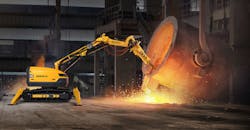Remote-Controlled Robots Boost Efficiency, Profits
Profitability is a complicated equation in any industry, and for foundries the working conditions add to the complexity. High heat, molten metal, dust, and chemicals limit the efficiency of crews and equipment, and that eats away at profits.
Consider the essential work of furnace and ladle maintenance. Some foundries find remote-controlled demolition machines can increase the efficiency of that necessary, ongoing task. It keeps operators safely at a distance from dangerous jobs — such as furnace tear-outs and cupola bottom drops — and it also provides the best power-to-weight ratio for tough jobs like breaking risers or cleaning ladles and troughs.
By increasing productivity, versatility, and safety, remote-controlled demolition machines can lead to more profitable processing.
Boosting productivity. Metalcasters have realized that using machines not only keeps workers safer, but also boosts productivity significantly. Take ladle cleaning, for example. A remote-controlled demolition machine with a single operator can complete this routine task in just 15 minutes. It could take up to five hours and several crew members to do the same with handheld tools. Along with speed, the machine provides more power and precision, for a better result.
One Wisconsin foundry previously scaled refractory lining from the walls of its holding furnaces with 10 laborers, in two crews, working 10-hour shifts. Depending on the volume of build-up, wall scaling took three to five days to complete.
When the foundry started using a remote-controlled demolition machine, they were able to finish in just two 10-hour shifts, with one operator and one spotter. And productivity continues to increase with each job crews tackle using demolition robots rather than manual methods. By reducing crew sizes for a particular task, managers can allocate personnel better to other work. As tasks take less time, plants can achieve more, maximizing production and profits.
Increased versatility. In addition to handheld equipment, demolition robots can replace mini excavators, skid steers, wrecking balls, and various other common machines, to streamline operations and cut overhead.
Demolition machines with a three-part arm provide flexibility and precision for accessing hard-to-reach areas, making easy work of slag and build-up on furnaces, cupolas, ladles, kilns, and runners. This flexibility and precision, paired with a small footprint, allows foundries to revolutionize some efforts. For example, a 4,000-pound remote-controlled demolition machine can easily remove refractory from the upper deck of a working furnace 75% faster and with more precision than a machine three times its size working from the floor.
For breaking risers, machines can replace sledgehammers, wrecking balls, and other blunt-force methods with safer, more efficient results. Reducing the number of machines moving around a foundry can positively impact the bottom line by reducing maintenance and other productivity-limiting tasks to a single machine. Because demolition robots require fewer personnel to operate safely, crews can be restructured to use the workforce better, increasing efficiency across the operation.
Heightened Safety. Perhaps the greatest benefit remote-controlled demolition robots have on overall profitability is heightened safety that provides peace of mind for managers and team members. Remote-controlled operation allows operators to choose the best position for viewing the work while staying clear of falling debris, dust, and toxic chemicals. For the hottest applications, like cupola-bottom drops, operators can remain 20 to 30 feet away, safe from sparks, molten metal, and other associated dangers. While some operations employ a forklift with a pneumatic jack for this routine task, that approach is inefficient and unnecessarily dangerous. The best demolition machines are designed to endure the heat without modifications, and for the most extreme jobs manufacturers offer heat-resistant options. And a demolition robot can complete a cupola drop with extreme precision in just 25 minutes while the operator never gets close enough to break a sweat.
By removing workers from dangerous situations, remote-controlled demolition machines help reduce workers’ compensation claims, which have the potential to cost a business hundreds of thousands of dollars each year.
Foundries have dangerous tasks to conduct, production requirements to meet, and workers to keep safe. Adding a remote-controlled demolition machine to the team can increase safety and productivity, and profits.
Jeff Keeling is the vice president of sales and marketing for Brokk Inc.
About the Author
Jeff Keeling
Vice President, Sales and Marketing
Jeff Keeling is the vice president of sales and marketing for Brokk Inc.
